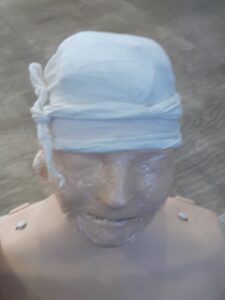Positive Points: Socially Distanced Training
Earlier in the month I attended a two-day First Aid at Work (FAW) requalification training course. This qualification must be updated every three years and was originally scheduled to be held in June. As with a lot of events this year, it was postponed and had to be conducted with social distancing measures in place. I couldn’t help but wonder how this COVID compliant training was going to work.
However, it was clear that the training providers, Underwood Training, had put a lot of thought into how the qualification could be achieved without the usual interactions between trainees. These measures started even before the training itself did.
Prior to attending the training we had completed a COVID questionnaire declaring ourselves symptom free and agreeing not to attend if we developed symptoms.
The training took place in a large church hall space. Trainees’ temperatures were taken on arrival and hand sanitiser was available. A one-way system had been created that led through the building.
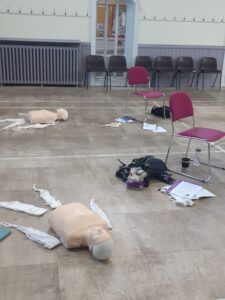 Trainees were each allocated a marked-out section of the badminton court. Each area had a chair, resuscitation dummy and bandages. We were asked to stay within our own section unless going to the bathroom.
Trainees were each allocated a marked-out section of the badminton court. Each area had a chair, resuscitation dummy and bandages. We were asked to stay within our own section unless going to the bathroom.
First Aid training, as a rule, is very practical and consists of lots of hands-on activities. For instance, trainees would normally practice checking each other for normal breathing, circulation issues and looking for bleeds and damage.
Other activities would require trainees to roll each other over into a Safe Open Draining Airway (SODA) position, more commonly known as the ‘recovery position’. Trainees would also practice applying wound dressings, bandages and slings.
Due to social distancing for COVID these were deemed to be unsafe so in this training we had to show competence in other ways.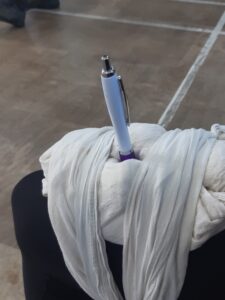
When checking for normal breathing normal practice is to place our cheek near the casualty (dummy). As an alternative, we were advised to use the wrist just above the glove for the 10-second check.
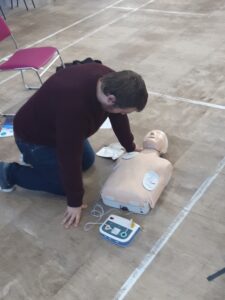 Our assessment for rolling someone into the SODA position was modified for COVID compliance.
Our assessment for rolling someone into the SODA position was modified for COVID compliance.
Each trainee remained in their own section. On assessment, we gave verbal instructions to the person in the next section. We guided them through the steps they needed to take to move into the correct position. We also explained where we would place ourselves and our hands to assist.
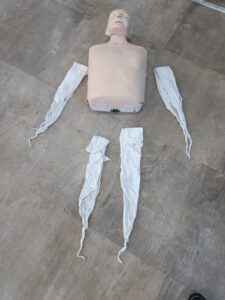 Our dummies were used for the circulation and damage checks. We used triangular bandages to create artistic arms and legs and to show how we would carry out the relevant checks. We wrapped ourselves up in bandages and slings, which was no easy task!
Our dummies were used for the circulation and damage checks. We used triangular bandages to create artistic arms and legs and to show how we would carry out the relevant checks. We wrapped ourselves up in bandages and slings, which was no easy task!
I must admit that the training and modified assessments did feel very strange. But these adaptations were necessary to create a safe way of practising the techniques and to show the assessor our competence.
The verdict on socially distanced FAW requalification training from Underwood Training is that it felt very odd not interacting with the other candidates. However, given the situation with COVID, it felt safe.
This two-day refresher training was useful for updating knowledge, acquiring new information and revising techniques. I am glad that I have these skills, but I hope I never need to put them into practice.
With thanks to the other candidates and to Underwood training for permitting the images I took to be used.




